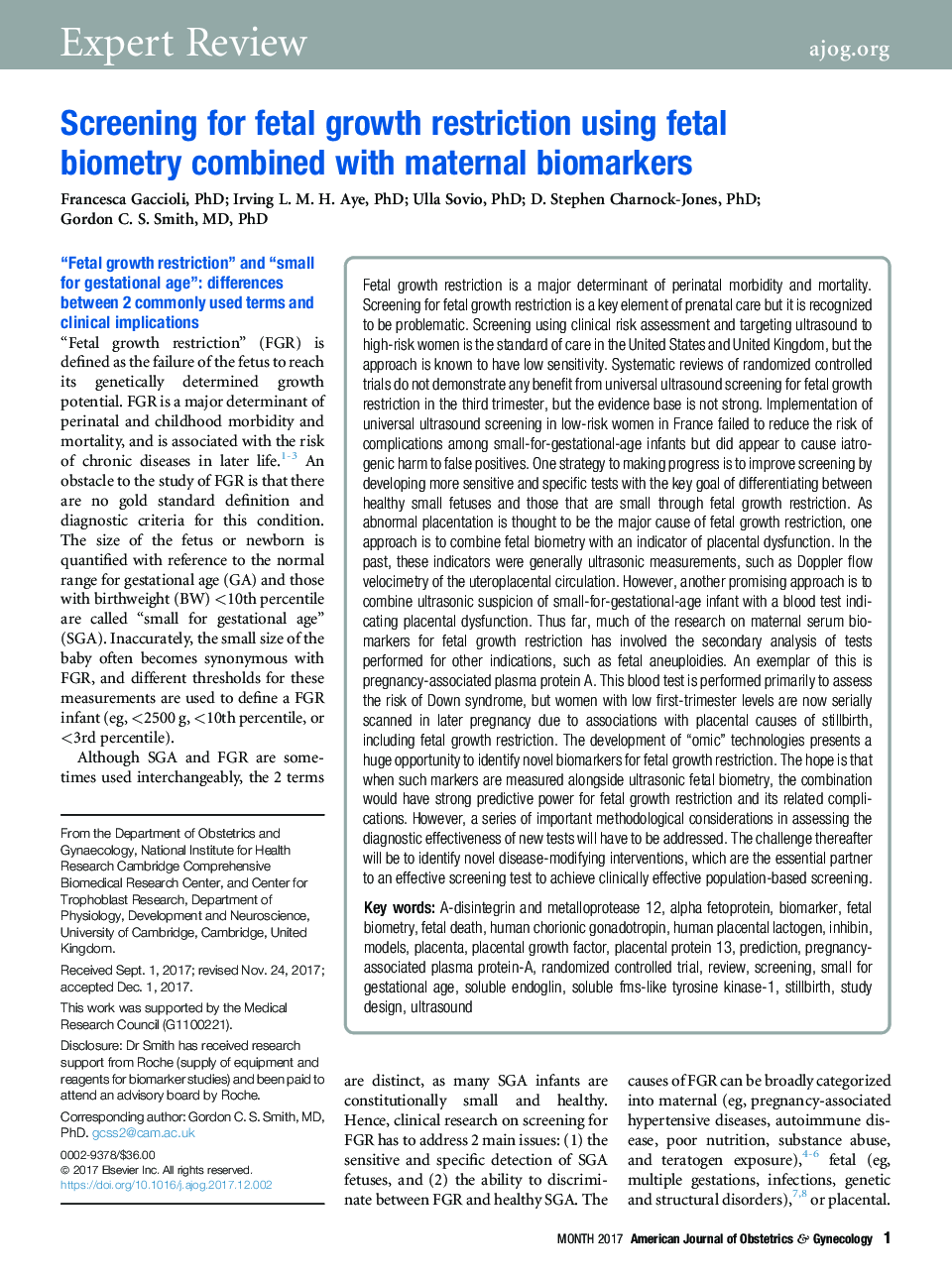| کد مقاله | کد نشریه | سال انتشار | مقاله انگلیسی | نسخه تمام متن |
|---|---|---|---|---|
| 8752809 | 1594866 | 2018 | 13 صفحه PDF | دانلود رایگان |
عنوان انگلیسی مقاله ISI
Screening for fetal growth restriction using fetal biometry combined with maternal biomarkers
ترجمه فارسی عنوان
غربالگری برای محدود کردن رشد جنین با استفاده از بیومتریک جنین همراه با بیومارکرهای مادر
دانلود مقاله + سفارش ترجمه
دانلود مقاله ISI انگلیسی
رایگان برای ایرانیان
کلمات کلیدی
InhibinRandomized controlled trial - آزمایش تصادفی کنترل شدهalpha fetoprotein - آلفا فتوپروتئینsoluble endoglin - آندوگلین محلولBiomarker - بیومارکرFetal Biometry - بیومتری جنینPlacenta - جفت Small for gestational age - حاملگی در سنین پائینStudy design - طراحی مطالعهplacental growth factor - عامل رشد جفتScreening - غربالگریUltrasound - فراصوتHuman placental lactogen - لاکتوزن جفت های انسانیsoluble fms-like tyrosine kinase-1 - مانند تریروزین کیناز 1، فسفات محلول استModels - مدل هاStillbirth - مردهزاییReview - مرورfetal death - مرگ جنینpregnancy-associated plasma protein-A - پروتئین A-پلاسمای مرتبط با بارداریPlacental protein 13 - پروتئین پلاسیک 13Prediction - پیش بینیhuman chorionic gonadotropin - گونادوتروپین کوریونی انسان
موضوعات مرتبط
علوم پزشکی و سلامت
پزشکی و دندانپزشکی
پزشکی و دندانپزشکی (عمومی)
چکیده انگلیسی
Fetal growth restriction is a major determinant of perinatal morbidity and mortality. Screening for fetal growth restriction is a key element of prenatal care but it is recognized to be problematic. Screening using clinical risk assessment and targeting ultrasound to high-risk women is the standard of care in the United States and United Kingdom, but the approach is known to have low sensitivity. Systematic reviews of randomized controlled trials do not demonstrate any benefit from universal ultrasound screening for fetal growth restriction in the third trimester, but the evidence base is not strong. Implementation of universal ultrasound screening in low-risk women in France failed to reduce the risk of complications among small-for-gestational-age infants but did appear to cause iatrogenic harm to false positives. One strategy to making progress is to improve screening by developing more sensitive and specific tests with the key goal of differentiating between healthy small fetuses and those that are small through fetal growth restriction. As abnormal placentation is thought to be the major cause of fetal growth restriction, one approach is to combine fetal biometry with an indicator of placental dysfunction. In the past, these indicators were generally ultrasonic measurements, such as Doppler flow velocimetry of the uteroplacental circulation. However, another promising approach is to combine ultrasonic suspicion of small-for-gestational-age infant with a blood test indicating placental dysfunction. Thus far, much of the research on maternal serum biomarkers for fetal growth restriction has involved the secondary analysis of tests performed for other indications, such as fetal aneuploidies. An exemplar of this is pregnancy-associated plasma protein A. This blood test is performed primarily to assess the risk of Down syndrome, but women with low first-trimester levels are now serially scanned in later pregnancy due to associations with placental causes of stillbirth, including fetal growth restriction. The development of “omic” technologies presents a huge opportunity to identify novel biomarkers for fetal growth restriction. The hope is that when such markers are measured alongside ultrasonic fetal biometry, the combination would have strong predictive power for fetal growth restriction and its related complications. However, a series of important methodological considerations in assessing the diagnostic effectiveness of new tests will have to be addressed. The challenge thereafter will be to identify novel disease-modifying interventions, which are the essential partner to an effective screening test to achieve clinically effective population-based screening.
ناشر
Database: Elsevier - ScienceDirect (ساینس دایرکت)
Journal: American Journal of Obstetrics and Gynecology - Volume 218, Issue 2, Supplement, February 2018, Pages S725-S737
Journal: American Journal of Obstetrics and Gynecology - Volume 218, Issue 2, Supplement, February 2018, Pages S725-S737
نویسندگان
Francesca PhD, Irving L.M.H. PhD, Ulla PhD, D. Stephen PhD, Gordon C.S. MD, PhD,
